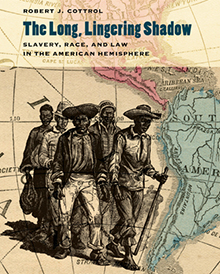Only about 5 percent of the Africans brought to the Americas as slaves came to the United States.
It’s a fact often forgotten in this country where many think the U.S.’s struggle to come to terms with slavery is unique, said Robert Cottrol, Harold Paul Green Research Professor of Law and Professor of History and Sociology.
“We tend to look at the issue too narrowly,” said Dr. Cottrol, a self-described longtime student of race relations and the law’s impact on them. “We focus on just the U.S. and are unaware that the same problems affect other countries.”
In “The Long, Lingering Shadow: Slavery, Race, and Law in the American Hemisphere,” published Feb. 1, Dr. Cottrol explores slavery and its legacy across nations, from the beginnings of the institution in the New World to today’s debates on affirmative action.
Latin America’s colonial powers, Spain and Portugal, relied on slavery to sustain their colonies’ economies as early as the 16th century. Countries in which slaves made up a significant portion of the population include Brazil—where 40 percent of enslaved Africans were taken—Cuba, the Dominican Republic, Colombia and Peru.
While several nations, including Mexico and Chile, abolished slavery as they became independent in the first half of the 19th century, emancipation came late to other societies in Latin America. Slavery wasn’t abolished in Cuba until 1886, while Brazil was the last country in the Americas to end slavery in 1888.
“Slavery was more intense and ultimately lasted longer in Latin America than in the United States,” said Dr. Cottrol.
Countries across the Americas experienced similar struggles with racial inequality and injustice before and after slavery. But the U.S. was unique in legalizing racial discrimination through the Jim Crow and other laws, he said.
“There was a fiercer resistance to emancipation in the United States, which was the only country in which emancipation was achieved as the result of civil war,” said Dr. Cottrol. In Latin American nations during the slave regimes, freed Afro-Americans were considered citizens and had more economic and social mobility even though there was considerable racial discrimination.
Roles reversed after the United States’ civil rights era. Despite significant racial discrimination in Latin America, there was no parallel to the U.S.’s civil rights movement, said Dr. Cottrol. The power of the movement in the U.S. forced the country to remedy legal injustice and strive toward equality. Many Latin American nations have only recently begun to focus on some of issues that the U.S. started to confront years ago.
For example, while the U.S. has been addressing affirmative action and equal opportunity for decades, Brazil only began tentative moves toward affirmative action in university admissions in 2001, and the country’s high court just last year declared affirmative action legal under Brazil’s 1988 constitution.
“People throughout the Americas now look at the U.S. civil rights movement as an example of how the law might be used to remedy the problem of racial inequality,” Dr. Cottrol said.
Dr. Cottrol is giving a book talk Monday at 6:30 p.m. at the City Club of Washington.


